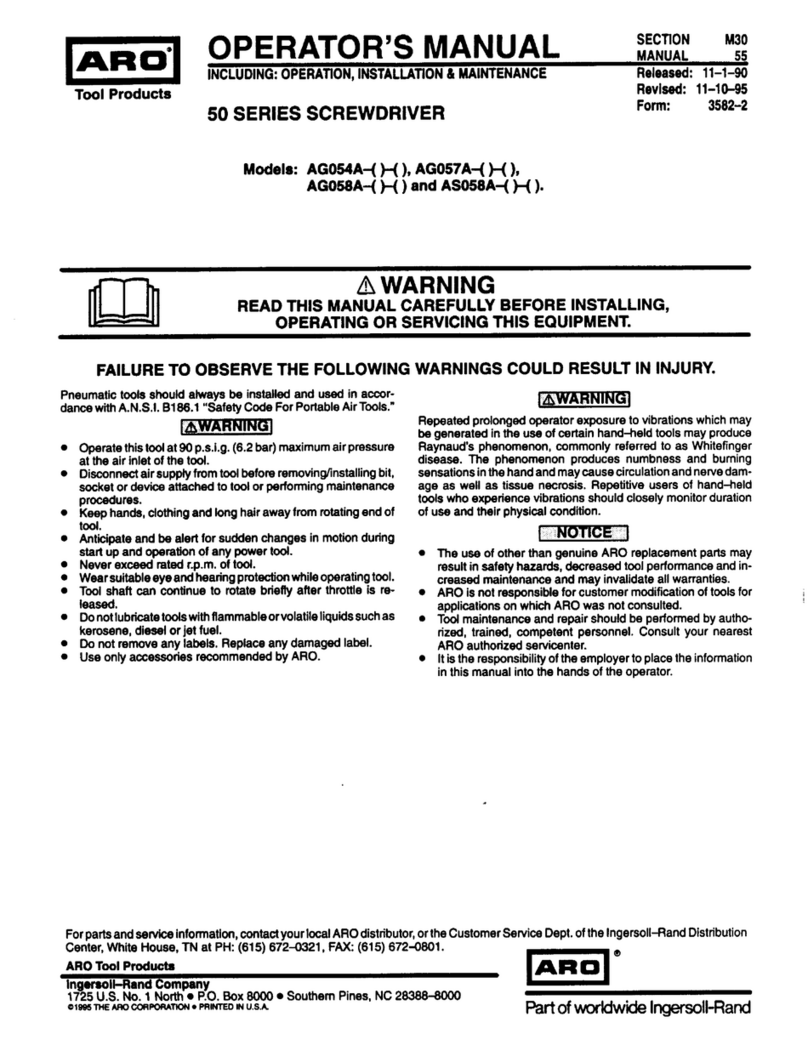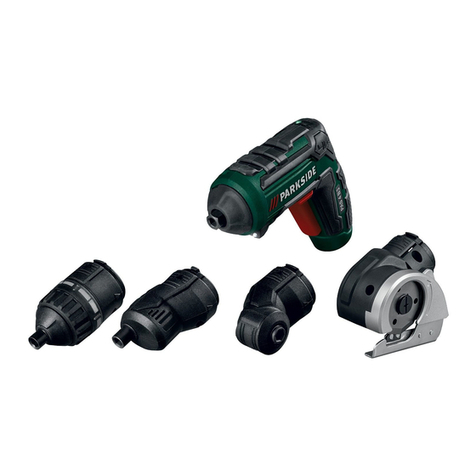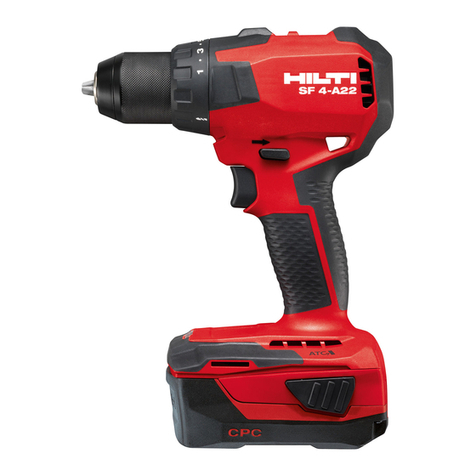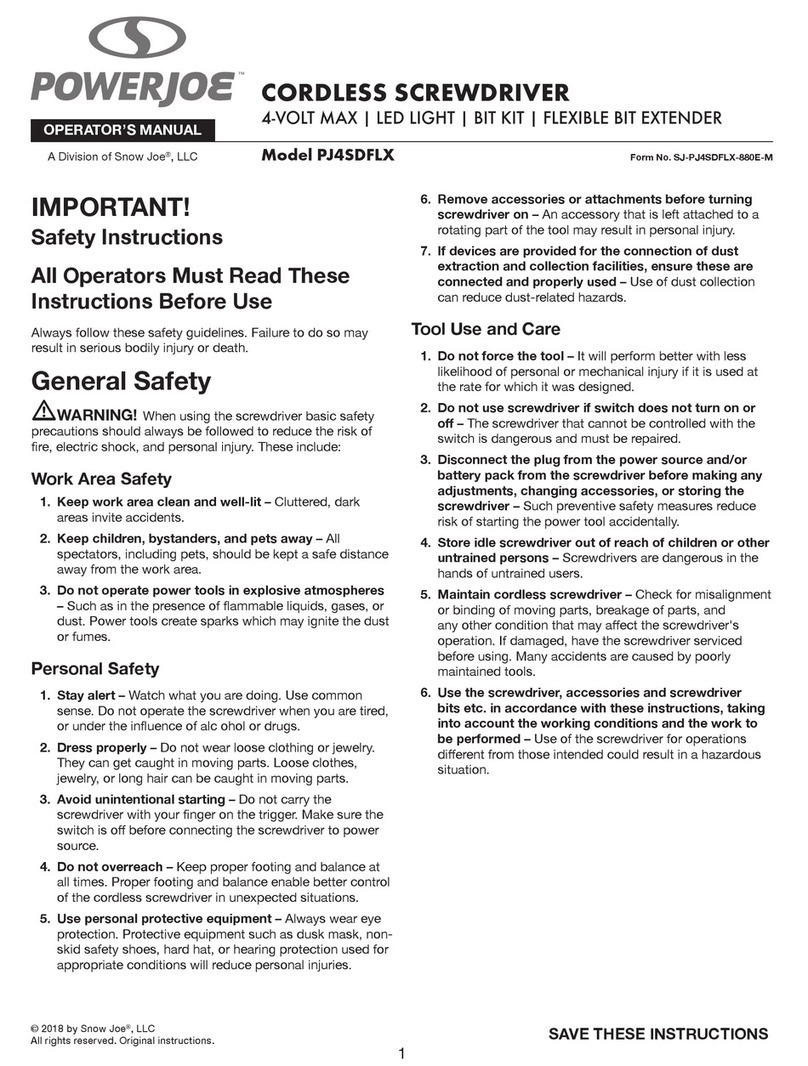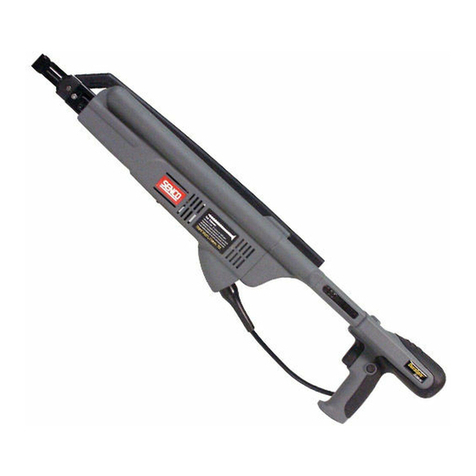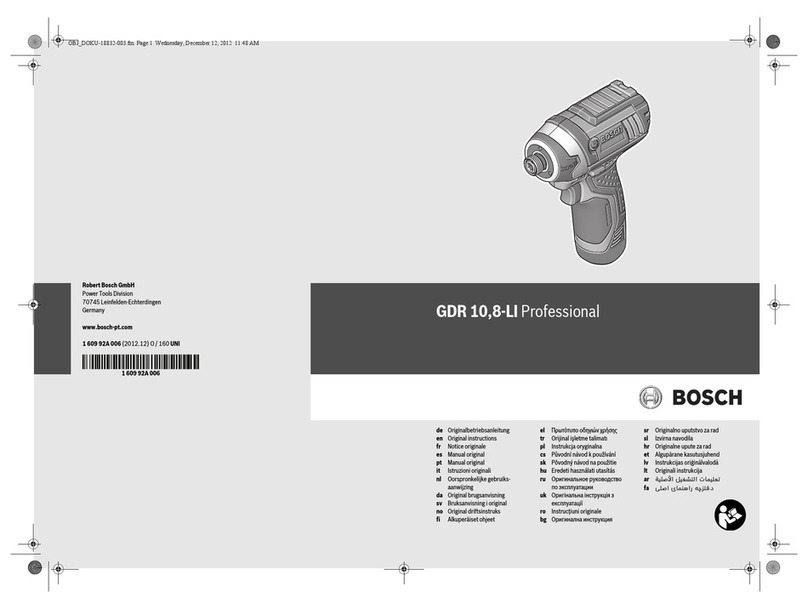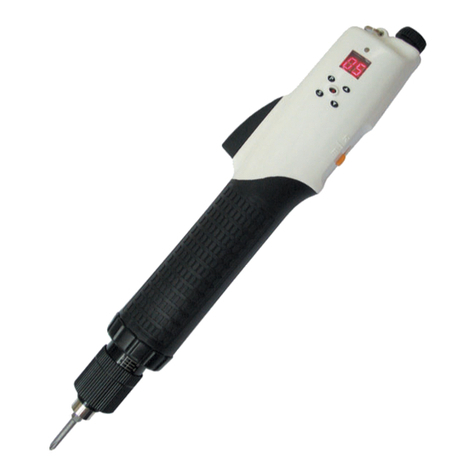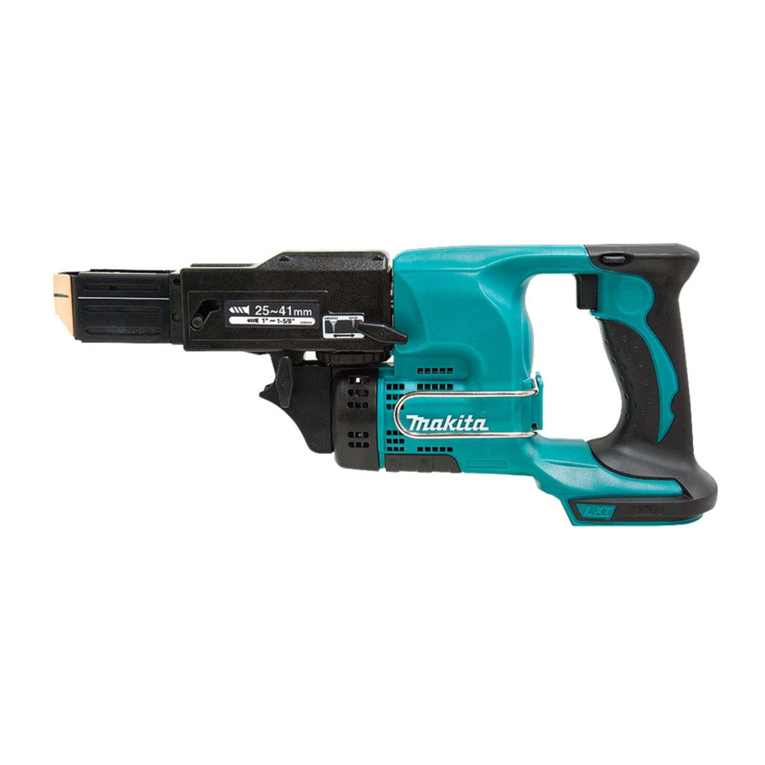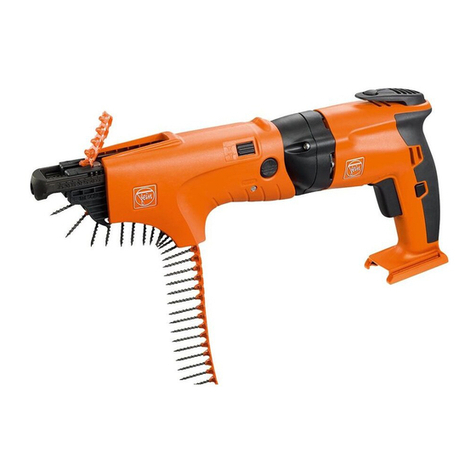Sovereign S010 User guide

3.6V SCREWDRIVER KIT
Article No. 612323
Model No. S010
HHGL Limited, MK9 1BA; HHGL (ROI) Limited, D02 X576 July 21
ORIGINAL INSTRUCTION MANUAL
Please read these instructions fully before starting assembly.
www.coreservice.co.uk
Technical Support & Parts
01904 727509
Mon-Fri 9am-5pm Sat-Sun 11am-4pm

2
CONTENTS
Contents 2
General safety warnings 3
Warning symbols 14
In the box 16
Operation 17
Maintenance and storage 22
Technical data 23
Recycling and disposal 25
Getting help 25
Warranty 26

3
GENERAL SAFETY INFORMATION
WARNING! Read all safety warnings,
provided with this power tool.
Failure to follow all instructions listed below
injury.
Save all warnings and instructions for future
reference.
The term 'power tool' in the warnings refers to your
mains-operated (corded) power tool or battery-
operated (cordless) power tool.
1) Work area safety
a. Keep work area clean and well lit.
Cluttered or dark areas invite accidents.
b. Do not operate power tools in explosive
atmospheres, such as in the presence of
flammable liquids, gases or dust.
Power tools create sparks which may ignite the
dust or fumes.
c. Keep children and bystanders away while
operating a power tool.
Distractions can cause you to lose control.
2) Electrical safety
a. Power tool plugs must match the outlet. Never
modify the plug in any way. Do not use any adaptor
plugs with earthed (grounded) power tools.

4
Unmodified plugs and matching outlets will reduce
risk of electric shock.
b. Avoid body contact with earthed or grounded
surfaces, such as pipes, radiators, ranges and
refrigerators. There is an increased risk of electric
shock if your body is earthed or grounded.
c. Do not expose power tools to rain or wet
conditions. Water entering a power tool will
increase the risk of electric shock.
d. Do not abuse the cord. Never use the cord for
carrying, pulling or unplugging the power tool.
Keep cord away from heat, oil, sharp edges
or moving parts. Damaged or entangled cords
increase the risk of electric shock.
e. When operating a power tool outdoors, use an
extension cord suitable for outdoor use. Use of
a cord suitable for outdoor use reduces the risk of
electric shock.
f. If operating a power tool in a damp location
is unavoidable, use a residual current device
(RCD) protected supply. Use of an RCD reduces
the risk of electric shock.
3) Personal safety
a. Stay alert, watch what you are doing and
use common sense when operating a power
tool. Do not use a power tool while you are
tired or under the influence of drugs, alcohol

5
or medication. A moment of inattention while
operating power tools may result in serious
personal injury.
b. Use personal protective equipment (PPE).
Always wear eye protection. Protective
equipment, such as a dust mask, non-skid safety
shoes, hard hat, or hearing protection used for
appropriate conditions will reduce personal
injuries.
c. Prevent unintentional starting. Ensure the
switch is in the 'off' position before connecting
to a power source and/or battery pack, picking
up or carrying the tool. Carrying power tools
with your finger on the switch or energising power
tools that have the switch on invites accidents.
d. Remove any adjusting key or wrench before
turning the power tool on. A wrench or a key left
attached to a rotating part of the power tool may
result in personal injury.
e. Do not overreach. Keep proper footing and
balance at all times. This enables better control
of the power tool in unexpected situations.
f. Dress properly. Do not wear loose clothing or
jewellery. Keep your hair, clothing and gloves
away from moving parts. Loose clothes, jewellery
or long hair can be caught in moving parts.
g. If devices are provided for the connection of
dust extraction and collection facilities, ensure
these are connected and properly used. Use of
these devices can reduce dust-related hazards.

6
h. Do not let familiarity gained from frequent use
of tools allow you to become complacent and
ignore tool safety principles. A careless action
can cause severe injury within a fraction of a
second.
4) Power tool use and care
a. Do not force the power tool. Use the correct
power tool for your application. The correct
power tool will do the job better and safer at the
rate for which it was designed.
b. Do not use the power tool if the switch does
not turn it on and off. Any power tool that cannot
be controlled with the switch is dangerous and
must be repaired.
c. Disconnect the plug from the power source
and/or the battery pack from the power tool
before making any adjustments, changing
accessories, or storing power tools. Such
preventive safety measures reduce the risk of
starting the power tool accidentally.
d. Store idle power tools out of the reach of
children and do not allow persons unfamiliar
with the power tool or these instructions
to operate the power tool. Power tools are
dangerous in the hands of untrained users.
e. Maintain power tools. Check for misalignment
or binding of moving parts, breakage of parts
and any other condition that may affect the
power tools operation. If damaged, have the

7
power tool repaired before use. Many accidents
are caused by poorly maintained power tools.
f. Keep cutting tools sharp and clean. Properly
maintained cutting tools with sharp cutting edges
are less likely to bind and are easier to control.
g. Use the power tool, accessories and tool bits,
etc., in accordance with these instructions,
taking into account the working conditions and
the work to be performed. Use of the power tool
for operations different from those intended could
result in a hazardous situation.
h. Keep handles and gripping surfaces dry, clean
and free from oil and grease. Slippery handles
and gripping surfaces do not allow for safe
handling and control of the tool in unexpected
situations.
5) Battery tool use and care
a. Recharge only with the charger specified by the
manufacturer. A charger that is suitable for one
type of battery pack may create a risk of fire when
used with another battery pack.
b. Use power tools only with specifically
designated battery packs. Use of any other
battery packs may create a risk of injury and fire.
c. When the battery pack is not in use, keep it
away from other metal objects, like paper clips,
coins, keys, nails, screws or other small metal
objects, that can make a connection from

8
one terminal to another. Shorting the battery
terminals together may cause burns or a fire.
d. Under abusive conditions, liquid may be
ejected from the battery; avoid contact. If
contact accidentally occurs, flush with water.
If liquid contacts eyes, additionally seek medical
help. Liquid ejected from the battery may cause
irritation or burns.
e. Do not use a battery pack or tool that is
damaged or modified. Damaged or modified
batteries may exhibit unpredictable behaviour
resulting in fire, explosion or risk of injury.
f. Do not expose a battery pack or tool to fire
or excessive temperature. Exposure to fire or
temperature above 130°C may cause explosion.
g. Follow all charging instructions and do not
charge the battery pack or tool outside
the temperature range specified in the
instructions. Charging improperly or at
temperatures outside the specified range may
damage the battery and increase the risk of fire.
6) Service
a. Have your power tool serviced by a qualified
repair person using only identical replacement
parts. This will ensure that the safety of the power
tool is maintained.
b. Never service damaged battery packs. Service
of battery packs should only be performed by the
manufacturer or authorised service providers.

9
Screwdriver safety warning
a. Hold the power tool by its insulated gripping
surfaces, when performing an operation where
the cutting accessory may contact hidden
wiring. Cutting accessories that contact a 'live'
wire may make exposed metal parts of the power
tool 'live' and could give the operator an electric
shock.
Safety Warnings for battery cells inside the tool
a. Do not dismantle, open or shred cells.
b. Do not short-circuit a charging terminal. Do
not store power tools haphazardly in a box
or drawer where the charging terminal may
short-circuit each other or be short-circuited
by conductive materials. When the power tool is
not in use, keep it away from other metal objects,
like paper clips, coins, keys, nails, screws or other
small metal objects, that can make a connection
from one charging terminal to another.
c. Do not expose the power tool to heat or fire.
Avoid storage in direct sunlight.
d. Do not subject a power tool to mechanical
shock.
e. In the event of battery leakage, do not allow
the liquid to come into contact with the skin
or eyes. If contact has been made, wash the
affected area with copious amounts of water
and seek medical advice.

10
f. Seek medical advice immediately if a cell has
been swallowed.
g. Keep the power tool clean and dry.
h. Wipe the charging terminals with a clean dry
cloth if they become dirty.
i. The power tool needs to be charged before use.
Always refer to this instruction manual and
use the correct charging procedure.
j. Do not keep a power tool on charge when not
in use.
k. After extended periods of storage, it may
be necessary to charge and discharge the
power tool several times to obtain maximum
performance.
l. The battery gives its best performance when it
is operated at normal room temperature (20°C
± 5°C).
m.When disposing of cells, keep cells of different
electrochemical systems separate from each
other.
n. Recharge only with the charger specified by
SOVEREIGN. Do not use any charger other than
that specifically provided for use with the
equipment. A charger that is suitable for one type
of battery may create a risk of fire when used with
another battery.
o. Keep the power tool out of the reach of
children.

11
p. Retain the original product literature for future
reference.
q. Dispose of properly.
r. Do not mix cells of different manufacture,
capacity, size or type within a device.
s. Do not use any cell which is not designed for
use with the equipment.
Safety warnings for the charger
WARNING Read all safety warnings and all
instructions. Failure to follow the warnings
and instructions may result in electric shock,
Save all warnings and instructions for future
reference.
This appliance can be used by children aged from 8
years and above, and persons with reduced physical,
sensory or mental capabilities or lack of experience
and knowledge if they have been given supervision
or instruction concerning the use of the appliance
in a safe way and understand the hazards involved.
Children shall not play with the appliance.
Cleaning and user maintenance shall not be made by
children without supervision.
If the supply cord is damaged, it must be replaced
by the manufacturer, its service agent or similarly
qualified persons in order to avoid a hazard.
1. Before charging, read the instructions.

12
2. After charging, disconnect the battery charger
from the supply mains. Then remove the chassis
connection and then the battery connection.
3. Do not charge a leaking battery.
4. Do not use chargers for functions other than
those for which they are designed.
5. Before charging, ensure your charger is matching
the local AC supply.
6. For indoor use; do not expose to rain.
7. The charging device must be protected from
moisture.
8. Do not use the charging device in the open.
9. Do not short out the contacts of the battery or
charger.
10.
11. Do not open the unit, and keep out of the reach
of children.
12. Do not charge the batteries of other
manufacturers or ill-suited models.
13. Ensure that the connection between the battery
charger and battery is correctly positioned and is
not obstructed by foreign bodies.
14. Keep the battery chargers slots free from foreign
objects, and protect against dirt and humidity.
Store in a dry and frost-free place.
15. When charging batteries, ensure that the battery
charger is in a well-ventilated area and away
from flammable materials. Batteries can get

13
hot during charging. Do not overcharge any
batteries. Ensure that batteries and chargers are
not left unsupervised during charging.
16. Do not recharge non-rechargeable batteries, as
they can overheat and break.
17. Longer life and better performance can be
achieved if the battery pack is charged when the
air temperature is between 18°C and 24°C. Do
not charge the battery pack in air temperatures
below 4.5°C, or above 40.5°C. This is important,
as it can prevent serious damage to the battery
pack.
18. Charge only battery packs of the same model
provided by SOVEREIGN and of models
recommended by SOVEREIGN.

14
WARNING SYMBOLS
Warning
Read the instructions
Wear ear protection
Wear eye protection
Wear a dust mask
Class II tool
The product complies with the applicable European
directives, and an evaluation method of conformity
for these directives was done.
Recycle unwanted materials instead of disposing
of them as household waste. All tools, hoses
and packaging should be sorted, taken to the
local recycling centre and disposed of in an
environmentally safe way.
Batteries contain Li-ion. Do not dispose of waste
batteries in domestic waste. Contact your local
authority to find out how to dispose of batteries.

15
Do not subject the battery to strong sunlight over
long periods of time. Do not leave on a heater (max.
45°C).
Do not throw into water
Do not throw on fire
The output plug has a positive centre pole and
negative outer pole.
For indoor use only
The product complies with the applicable UK
directives, and an evaluation method of conformity
for these directives was followed.

16
IN THE BOX
Description
1. Chuck
2. Adjustable handle lock switch
3. Torque setting
4. Soft grip
5. Charging socket
6.
7.
8. LED light
9. Battery capacity indicator
10.Battery capacity button
Accessories
1 piece 3-5hours charger
52 piece accessories
1 piece bit holder
9 10
8
7
5
4
6
231

17
OPERATION
NOTE: Before using the tool, read the
instruction book carefully.
Intended Use
This tool is intended for driving in and loosening screws.
BEFORE PUTTING INTO OPERATION
1. CHARGING THE BATTERY (SEE FIG. A)
NOTE:
a) Do not use any charger other than that specifically provided
for use with the equipment.
b) If the battery pack is very hot, you must remove your
battery pack from the charger and allow time for the battery
to cool down before recharging.
c) The battery in your new tool is not charged when it leaves
the plant. Therefore it must be fully charged before using the
first time.
d) Please charge the battery to reach full or no less than half
charge before storage. If the tool will not be used for long
periods of time, charge the battery every 3-6 months.
Plug the charger plug into a suitable power outlet. Next,
connect the screwdriver to the battery charger. The battery
capacity indicator will illuminate during charging.
Let the battery charge for 3-5 hours. The battery is fully
charged as soon as the battery capacity indicator is no longer
lit. Then unplug the charger. Disconnect the charger from the
screwdriver. The screwdriver is ready to be used.

18
IMPORTANT: When charging, the charger and
screwdriver may become warm to the touch, this
is normal and does not indicate a problem.
WARNING! When the battery charge runs out after
continuous use or exposure to direct sunlight or
heat, allow time for the tool to cool down before
re-charging to achieve the full charge.
OPERATION
1. FITTING AND REMOVING BITS (SEE FIG. B)
Insert the bit into the bit holder and push the bit into the
chuck as far as possible. To remove the bit, simply pull it out
of the bit holder.
2. FORWARD/REVERSE SWITCH (SEE FIG, C1, C2)
For screw driving, use forward rotation marked 'L' (lever is
moved to the left). Only use reverse rotation marked 'R' (lever
is moved to the right) to remove screws or release a jammed
drill bit.
WARNING! Never change the direction of rotation
when the chuck is rotating. Wait until it has stopped.
Power
outlet
Charger
plug
A

19
3. SWITCH LOCK (SEE FIG. D)
This helps to reduce the possibility of accidental starting when
not in use. To lock the switch, place the forward and reverse
rotation selector in the centre position.
4. ON/OFF SWITCH
screwdriver.
5. ADJUSTABLE HANDLE
This tool can be used with a straight grip or pistol grip.
(SEE FIG. E, F)
Push the adjustable handle lock switch (2) forward, adjust the
handle (4) to your preferred position; the adjustable handle
lock switch will recover itself, and then you can use the tool.
Bit
B C1
C2 D

20
6. USING THE SIGHTLIGHT
7. BATTERY CAPACITY INDICATOR
Press the battery capacity indicator button to show the battery
capacity.
When the battery capacity indicator lights up red, the battery
has less than 30% of its capacity and should be charged.
Full power Green + Yellow + Red
Full power but will require
charging shortly Yellow + Red
Needs charging Red
8. SET THE REQUIRED TORQUE (SEE FIG. G)
By rotating the torque setting (3) behind the chuck, it is
possible to adjust the output torque to each of 6 settings. The
range of 6 torque settings allows better control when using, as
it prevents overtightening of the screws.
The numbers are used to indicate the level of torque.
E F
This manual suits for next models
1
Table of contents
Popular Power Screwdriver manuals by other brands
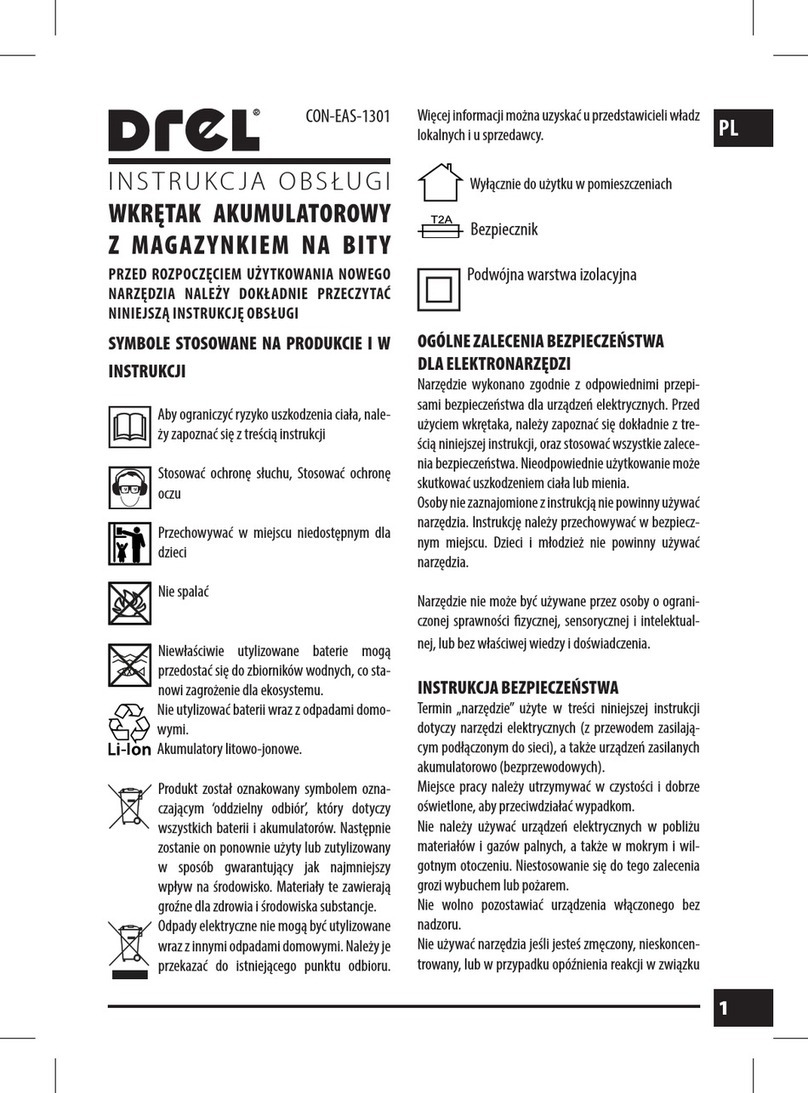
Drel
Drel CSD36H owner's manual
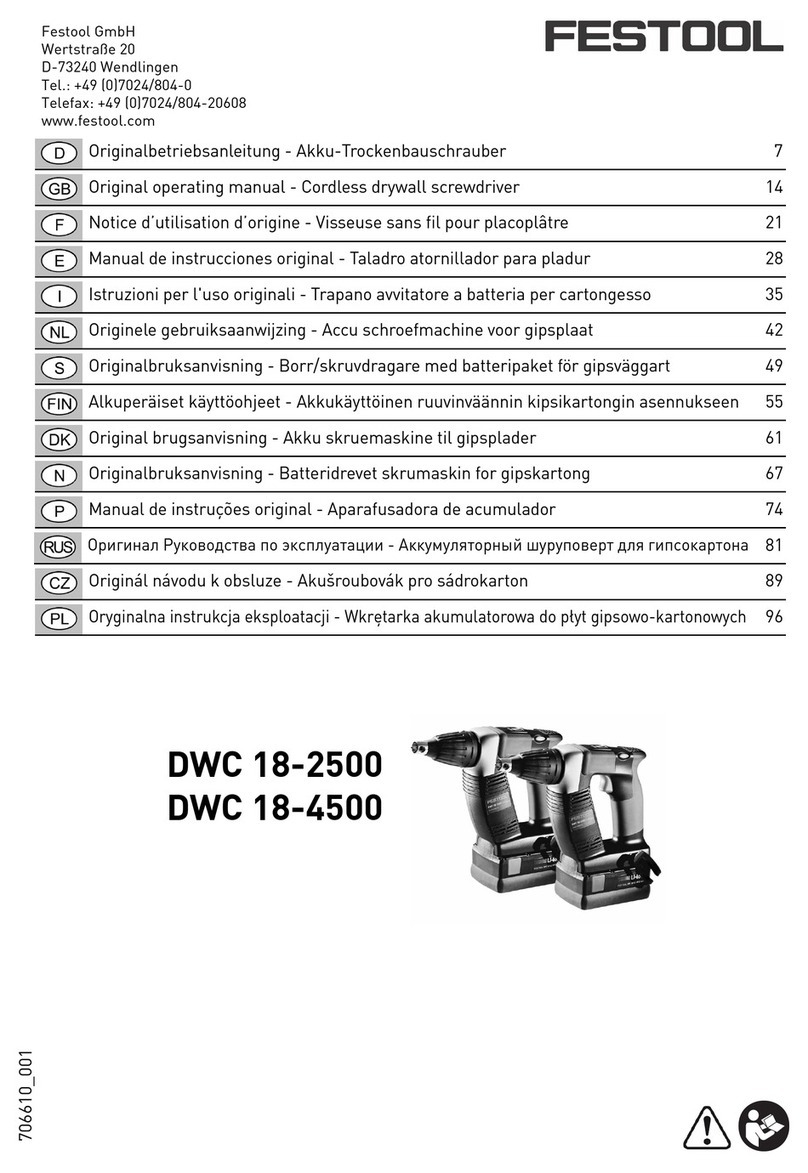
Festool
Festool DWC 18-2500 Original operating manual

Makita
Makita FS2500K instruction manual
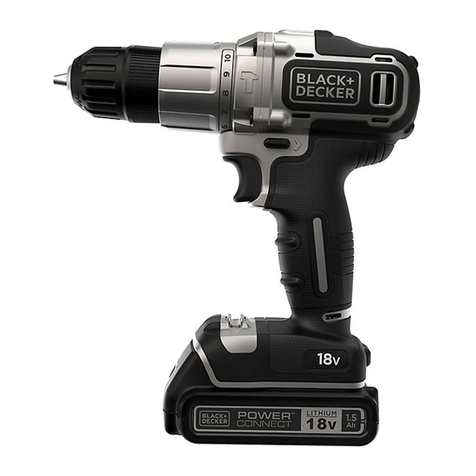
Black & Decker
Black & Decker BCD700SAP1 Original instructions

Chicago Electric
Chicago Electric 99683 Set up and operating instructions
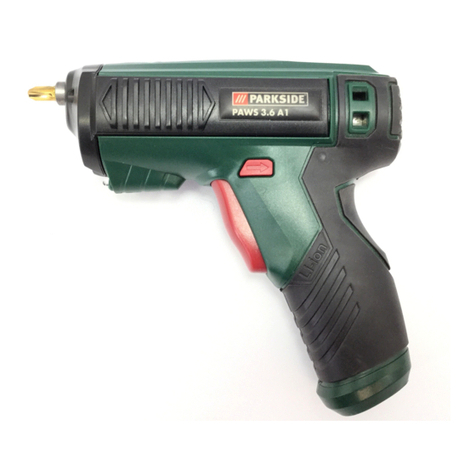
Parkside
Parkside PAWS 3.6 A1 original operation manual
